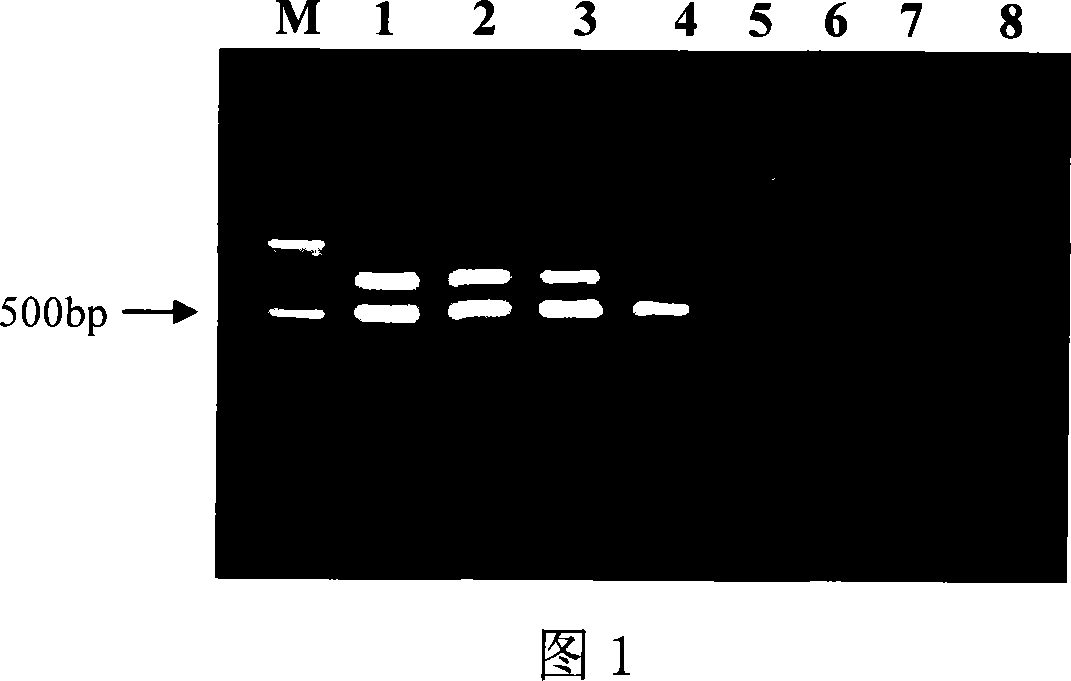Multi-PCR fast detecting reagent kit for salmonella and bacillus coli 0157 in livestock and poultry meat and testing method thereof
A detection kit and Salmonella detection technology, applied in biochemical equipment and methods, microorganism-based methods, microorganism measurement/inspection, etc., can solve the problems of low specificity, difficulty in confirming or excluding Escherichia coli O157 contamination, and achieve The effect of good specificity and good application prospect
- Summary
- Abstract
- Description
- Claims
- Application Information
AI Technical Summary
Problems solved by technology
Method used
Image
Examples
Embodiment 1
[0024] Example 1: Primer specific detection
[0025] According to the designed 2 pairs of specific PCR primers, the negative and positive results of 27 common pathogenic bacteria were tested in Table 2. The rfbE gene was detected in 5 strains of E. coli O157, the above genes were not detected in other serotypes of E. coli, and the above-mentioned specific amplification bands were not seen in all non-E. coli strains; invA genes were detected in 10 strains of Salmonella. The results show that the two pairs of primers are only specific to their target organisms.
[0026] Table 2 Primer specific electrophoresis results
[0027] Strain
[0028] E.coli
[0029] Note: NCTC (United Kingdom National Collection of Type Cultures), CMCC (National Center for Medical Culture of Collections), ATCC (American Type Culture Collection, American Standard Culture Collection) Center), GDCIQ (Guangdong Entry-Exit Inspection and Quarantine Bureau, Guangdong Entry-Exit Inspection and Q...
Embodiment 2
[0030] Example 2: Detection of primer sensitivity
[0031] The standard strain S.typhi CMCC50115, E.coli O157 NCTC12900 culture solution (plate count results were 2.4 × 10 9 cfu / mL and 2.2×10 9cfu / mL) was mixed in equal amounts, and then 10 times of gradient dilutions were made, and then each gradient dilution was inoculated into 90 mL nutrient broth culture broth containing 10 g minced pork. After culturing for 4 hours, DNA was extracted for multiplex PCR detection. The result is shown in Figure 1. The highest detectable dilution concentration is the highest detection sensitivity of multiplex PCR in the sample. The result shows that the highest detectable dilution is 10 -7 , The concentrations of the two bacteria that can be detected are: 2.4×10 2 cfu / mL Salmonella and 2.2×10 2 cfu / mL Escherichia coli O157.
Embodiment 3
[0032] Example Three: Detection of Salmonella and Escherichia coli O157 in pork using the multiplex PCR rapid detection kit of the present invention
[0033] 1. Sample pretreatment
[0034] Using aseptic operation, randomly sample 10 g, add it to 90 mL nutrient broth culture solution, and incubate at 37°C for 4 hours.
[0035] 2. Sample DNA extraction
[0036] 1) 1.5mL bacterial solution, centrifuged at 8000r / min for 10min, and remove the supernatant; 2) Add 567μL of TE to suspend the pellet, and add 30μL of 100g / L SDS, 3μL of 20mg / mL proteinase K, mix well, and incubate at 37°C for 1h; 3) Add 100μL of 5mol / L NaCl and mix well; 4) Add 80μL of CTAB / NaCl solution, mix well, and incubate at 65°C for 20min; 5) Use an equal volume of phenol: chloroform: isoamyl alcohol (25: 24:1, v: v: v) Extraction, centrifuge at 10000r / min for 10 minutes, transfer the supernatant to a clean centrifuge tube; 6) Extract with an equal volume of chloroform: isoamyl alcohol (24:1, v: v), take the supernat...
PUM
 Login to View More
Login to View More Abstract
Description
Claims
Application Information
 Login to View More
Login to View More - R&D
- Intellectual Property
- Life Sciences
- Materials
- Tech Scout
- Unparalleled Data Quality
- Higher Quality Content
- 60% Fewer Hallucinations
Browse by: Latest US Patents, China's latest patents, Technical Efficacy Thesaurus, Application Domain, Technology Topic, Popular Technical Reports.
© 2025 PatSnap. All rights reserved.Legal|Privacy policy|Modern Slavery Act Transparency Statement|Sitemap|About US| Contact US: help@patsnap.com

